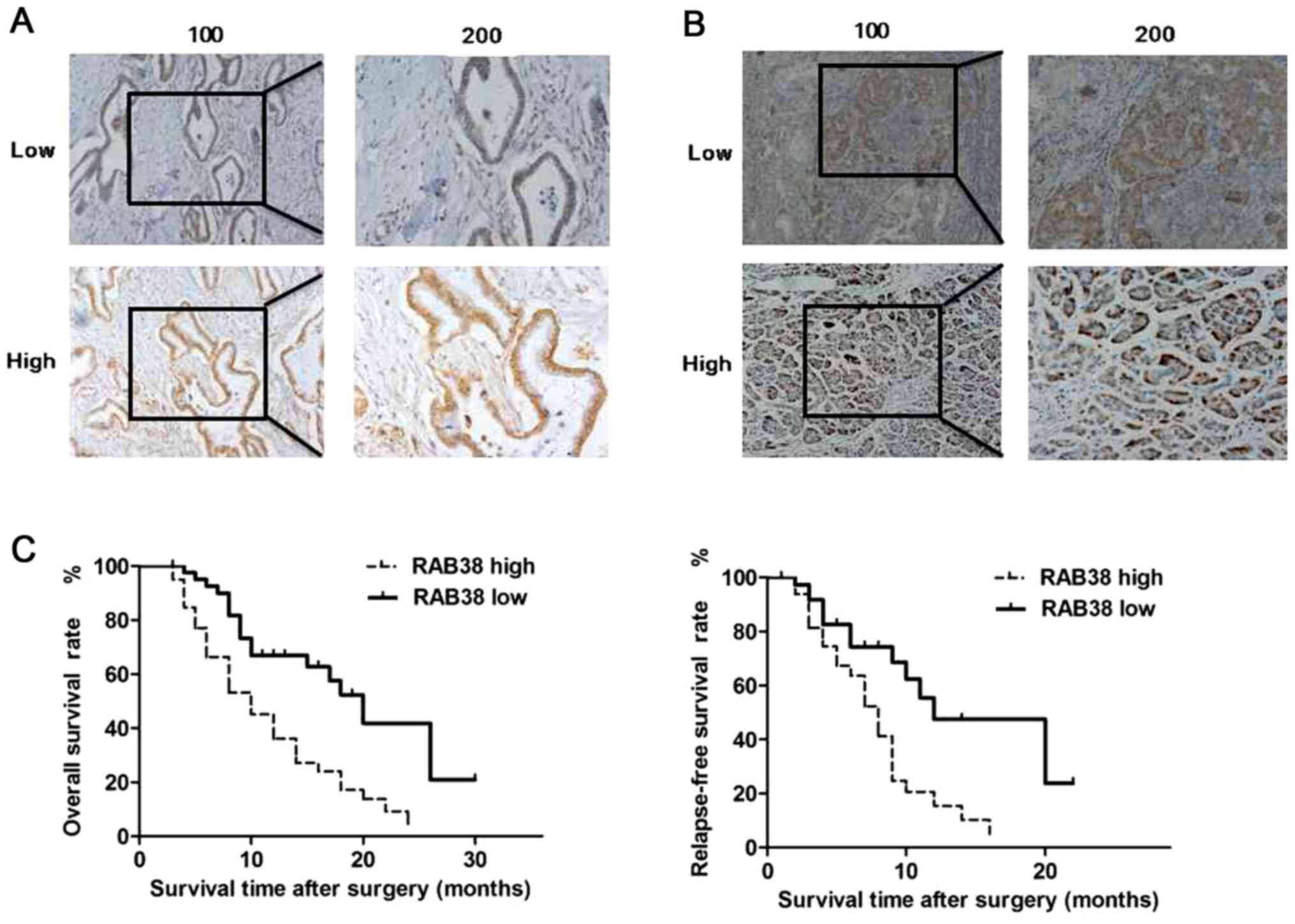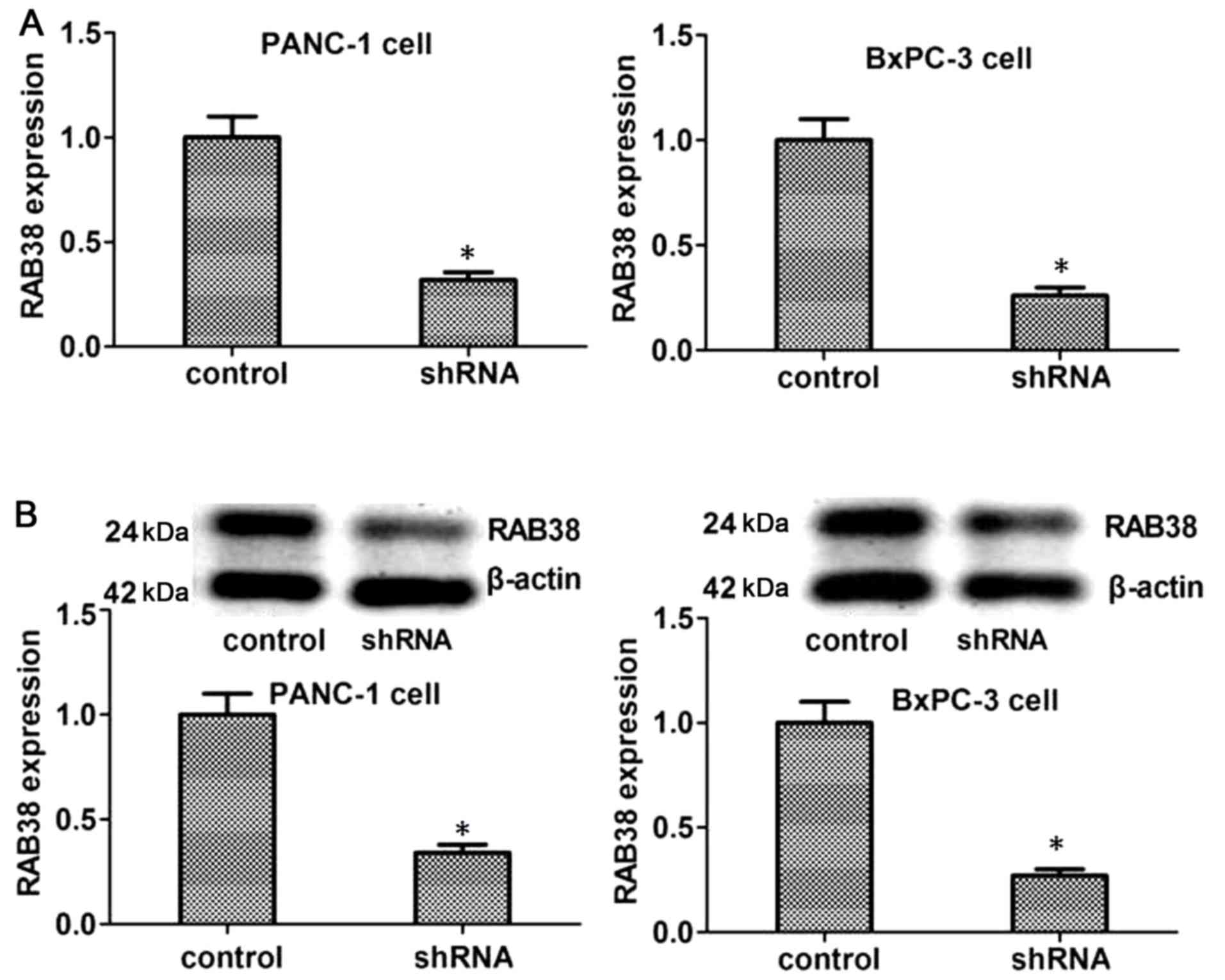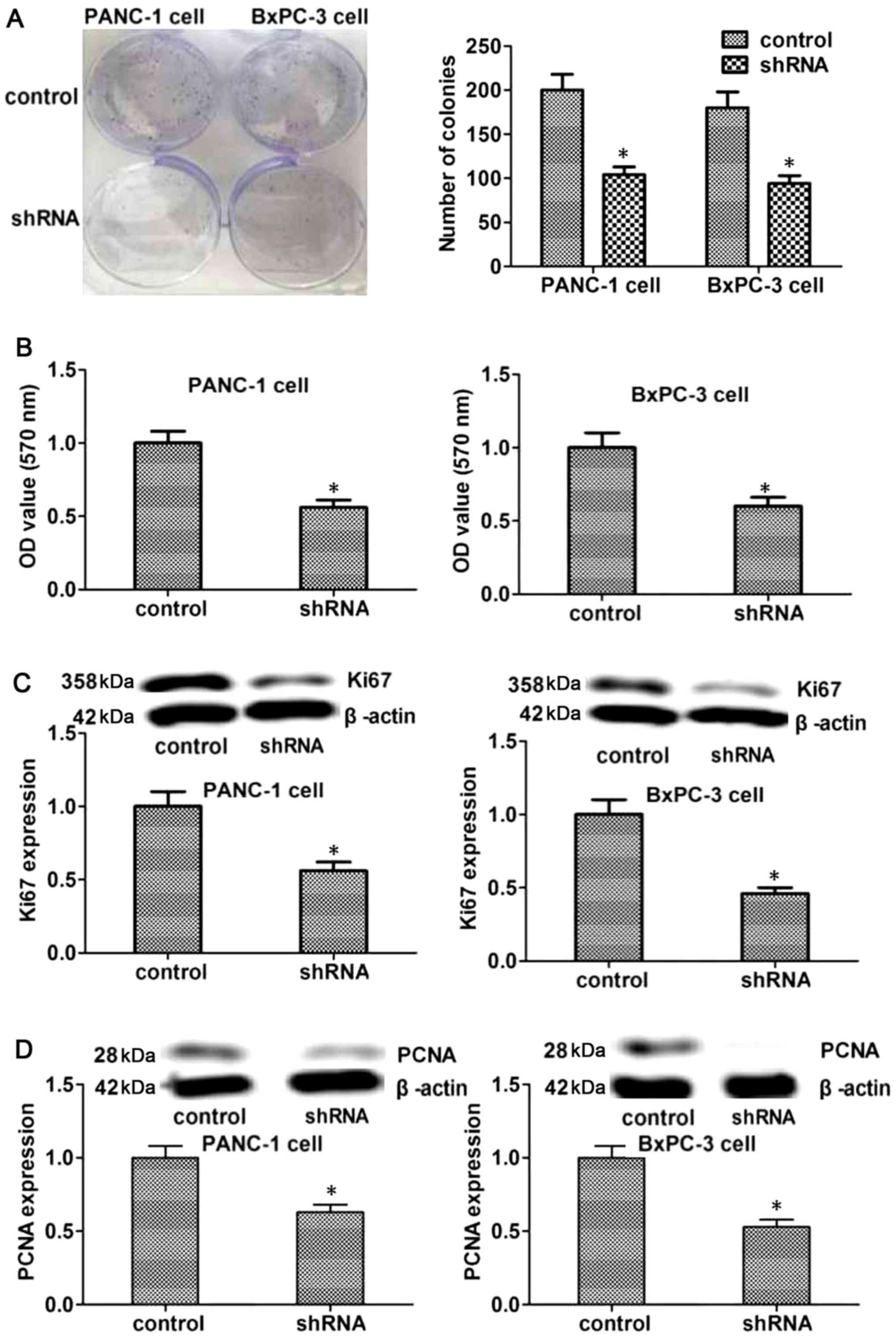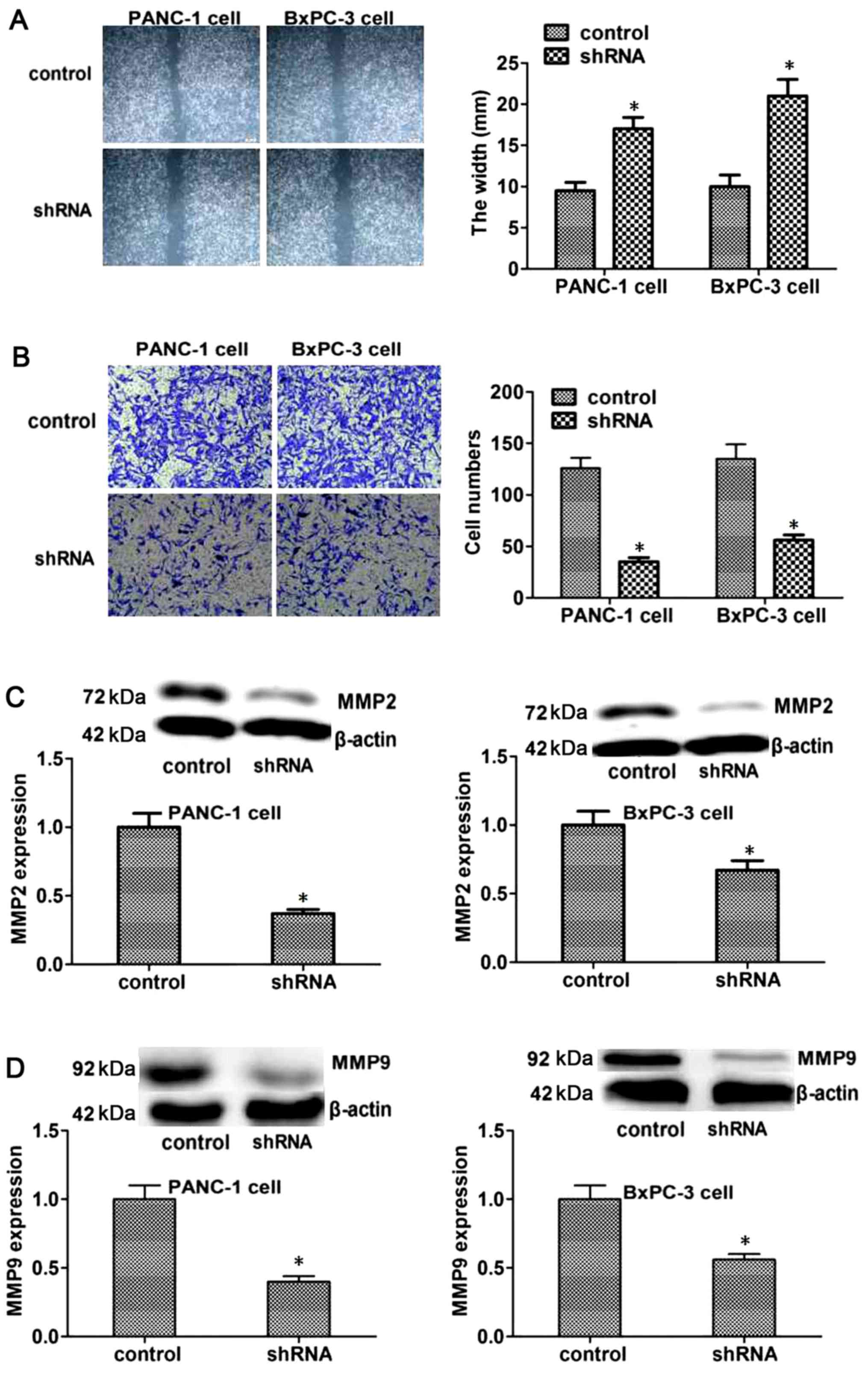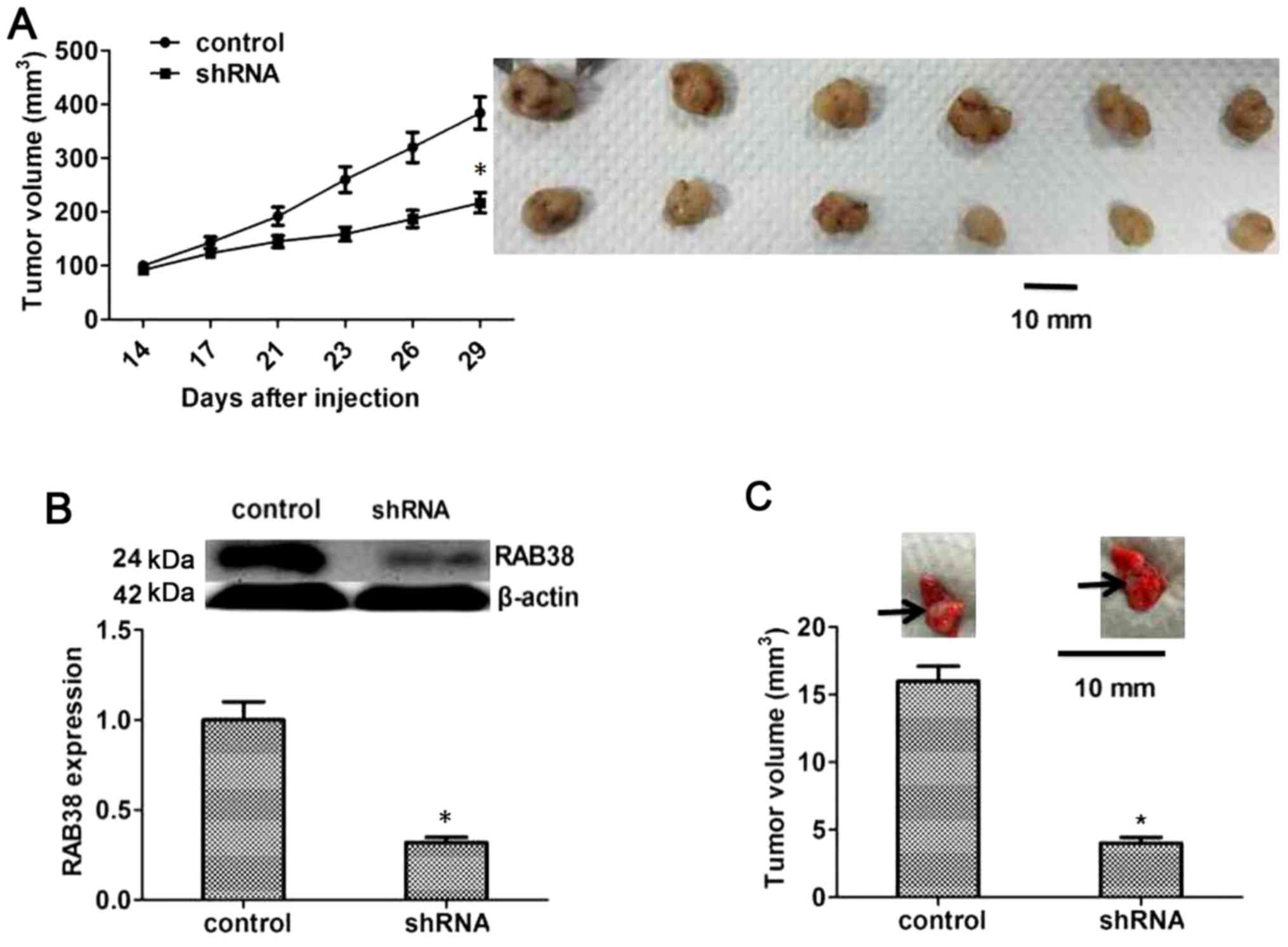High expression of RAB38 promotes malignant progression of pancreatic cancer
- Authors:
- Published online on: December 10, 2018 https://doi.org/10.3892/mmr.2018.9732
- Pages: 909-918
-
Copyright: © Li et al. This is an open access article distributed under the terms of Creative Commons Attribution License.
Abstract
Introduction
Pancreatic cancer is a commonly diagnosed cancer and one of the main causes of cancer-associated mortality (1,2). The incidence of pancreatic cancer increases yearly, and 95% of pancreatic cancer cases involve adenocarcinomas (3–5). It is reported that the 5-year survival rate of pancreatic cancer patients is only 20% following surgical resection, chemotherapy and radiation treatment (6,7). The majority of patients are diagnosed at a late stage with regional invasion or distant metastasis, due to the lack of recognizable clinical symptoms or signs (8–10). Therefore, it is urgent to screen effective biomarkers for the prediction of tumor progression.
Ras-Related Protein Rab-38 (RAB38) is a member of the RAB small G protein family (11), which is involved in regulating signal transduction and cellular processes, including membrane trafficking, cell growth and differentiation (12–14). It is documented that the point mutations of RAB38 at the GTP binding domain can result in the Hermansky-Pudlak syndrome in humans (15–17). Previous studies reported that RAB38 was associated with the synthesis, storage and transport of melanin pigments in the biogenesis of melanosomes (18,19). In addition, the RAB38 protein was overexpressed at the RNA level in melanoma cancer (20,21). It has also been indicated that the high expression of RAB38 increased the progression of gliomas, and was associated with poorer prognosis (17). However, the clinical significance and potential function of RAB38 in the progression of pancreatic cancer remain unclear.
In the present study, the RAB38 expression level was analyzed in pancreatic cancer specimens from 82 patients, and its correlation with the clinicopathological characteristics and survival rate of these patients was examined. The study then established RAB38 knockdown PANC-1 and BxPC-3 cell lines by RNA interference (RNAi) technology, followed by assessing the effect of RAB38 silencing on the proliferation, migration and invasion of pancreatic cancer cells. In addition, the effect of low RAB38 expression was further investigated in PANC-1 ×enograft tumor-bearing mice.
Materials and methods
Specimen collection and ethics statement
Procedures involving human samples and animals used in the present study were approved by the Ethics Committee of the Secondary Hospital of Tianjin Medical University (Tianjin, China). Written informed consent was provided by all the participants of the present study. Subsequent to obtaining the Institutional Review Board approval, the current study identified 82 patients undergoing standard radical resection of pancreatic cancer in the Secondary Hospital of Tianjin Medical University between March 2012 and December 2015. All the patients had no history of preoperative radiotherapy, chemotherapy or neoadjuvant chemotherapy. All the patients did not manifest signs of tumor metastasis, as evidenced by cross-sectional imaging. Normal para-carcinoma tissues adjacent to carcinoma were obtained. All specimens were stored embedded in paraffin, at room temperature. The clinicopathological characters (such as age, sex, pTMN stage, tumor grade, tumor size, lymph metastasis, and vascular invasion) and outcome information of patient were recorded.
Immunohistochemical (IHC) analysis
IHC analysis was performed as described previously (22). Briefly, specimens were fixed in 4% paraformaldehyde, embedded in paraffin and cut into 4-µm sections. Following deparaffinization and rehydration, the sections were subjected to antigen retrieval. Anti-RAB38 antibody (bs-11244R; BIOSS, Beijing, China) at 4°C overnight (12 h) was used to detect the RAB38 expression in the specimens and horseradish peroxidase (HRP; PV-6000; OriGene Technologies, Inc., Beijing, China)-labeled secondary antibody at room temperature for 20 min. Color development was then performed by incubating with DAB provided in the kit (ZLI-9018; OriGene Technologies, Inc., Beijing, China), and the sections counterstained with 0.5% hematoxylin at room temperature for 20 sec for cell nuclei and mounted. Images of the sections were subsequently captured with a light microscope (Olympus BX-51; Olympus Corporation, Tokyo, Japan).
All specimens were reviewed and scored by investigators blinded to the clinical characteristics of patients. The expression of RAB38 in tumor cells was scored as follows: 0, no positive expression in tumor cells; 1, <25% positive expression in tumor cells; 2, 25–50% positive expression; and 3, >50% positive expression. The staining intensity was also determined according to the following scores: 0 (no staining), 1 (weak, light yellow staining), 2 (moderate, yellowish brown staining) and 3 (strong, brown staining). The staining index was calculated as follows: Staining index = (staining intensity score) × (tumor cell staining grade). A staining index score of ≥4 was defined as high RAB38 expression, while a staining index of <4 represented low expression of RAB38.
Cells and animals
PANC-1 and BxPC-3 human pancreatic adenocarcinoma cell lines were purchased from the American Type Culture Collection (Manassas, VA, USA). PANC-1 cells were cultured in Dulbecco's modified Eagle's medium, and BxPC-3 cells were cultured in Roswell Park Memorial Institute 1640 medium from The Cell Resource Center of Peking Union Medical College (Beijing, China). All cells were incubated in medium containing 10% fetal bovine serum and 1% penicillin combined with streptomycin at 37°C in 5% CO2.
Female BALB/c nude mice (n=30; 6–8 weeks old; 20–25 g) were purchased from the Academy of Military Science (Beijing, China). The mice were maintained under a germ-free environment in individual ventilated cages, and at 20°C, humidity 40–60%, 12-h light/dark cycle and ad libitum access to standard lab chow and water.
Small hairpin RNA (shRNA) transfection
Pancreatic cancer cells were seeded in 6-well plates at a concentration of 3×104 cells/well and cultured overnight. The plasmid TRCN0000048183 and negative vector were purchased from Open Biosystems, Inc. (Huntsville, AL, USA) and designated as sh-RAB38 (23). Diluted shRNAs were added to Lipofectamine® 2000 (11668027; Thermo Fisher Scientific, Inc., Waltham, MA, USA) for 20 min, and then the cells were transfected using the mixture and incubated at 4°C for 6 h. Subsequently, the transfection effect was evaluated by reverse transcription-quantitative polymerase chain reaction (RT-qPCR) and western blot analysis.
RT-qPCR assay
Total RNA in human cells was isolated by TRIzol reagent (Invitrogen; Thermo Fisher Scientific, Inc.). The OD260/OD280 of the RNA was 2.0. RNA was then reverse-transcribed into cDNA using PrimeScript RT Reagent kit (Takara Bio, Inc., Shiga, Japan). Next, qPCR was performed by Primer Mix Taq II (Takara Biotechnology Co., Ltd., Dalian, China) with the following conditions (24): 95°C for 2 min (1 cycle), 95°C for 5 sec, 55°C for 30 sec, and 72°C for 30 sec (35 cycles) and final extension at 72°C for 6 min. Using the 2−∆∆Cq method (25), the relative expression level was normalized by the internal standard β-actin. The primer sequences used were: RAB38, 5′-GTAATCGGCGACCTAGGTG-3′ (forward) and 5′-TCCATTCCCGGAACCTTCAC-3′ (reverse); β-actin, 5′-CAGCTCACCATGGATGATGATATC-3′ (forward) and 5′-AAGCCGGCCTTGCACAT-3′ (reverse).
Western blot analysis
The nuclear and cytoplasmic protein was extracted by protein lysate, and the concentration of protein was measured by a protein assay kit (Beyotime Institute of Biotechnology, Haimen, China). Immunoblotting was then performed as previously described (6). Briefly, protein (30 µg) was separated by 10% SDS-PAGE and transferred onto polyvinylidene difluoride membranes. The membranes were blocked by 1% BSA at 4°C for 2 h and then incubated with appropriate primary antibodies at 4°C overnight, followed by incubation with secondary antibodies at 37°C for 2 h. The primary antibodies used were as follows: Rabbit anti-RAB38 (1:400; bs-11244R; BIOSS), rabbit anti-β-actin (1:1,000; ab5694; Abcam, Cambridge, UK), rabbit anti-Ki67 (1:1,000; ab16667; Abcam), rabbit anti-proliferating cell nuclear antigen (PCNA; 1:500; ab18197; Abcam), rabbit anti-matrix metalloproteinase 2 (MMP2; 1:1,000; ab37150; Abcam) and rabbit anti-MMP9 (1:1,000; ab38898; Abcam). The secondary antibodies used in the assay were polyclonal goat anti-rabbit IgG antibodies (1:10,000; 711–1122; Rockland Immunochemicals, Inc., Limerick, PA, USA). Subsequently, the protein was visualized by Immobilon Western Chemiluminescent HRP Substrate (EMD Millipore, Billerica, MA, USA) and detected by Tanon-5500 Chemiluminescent Imaging System (Tanon Science & Technology Co., Ltd., Shanghai, China). Western blot data were quantified by densitometric analysis with ImageJ software version LSM880 (National Institutes of Health, Bethesda, MD, USA), and the relative expression level was normalized by the internal standard β-actin.
Cell proliferation
Colony formation assays were used to test the proliferation ability of cells. Briefly, cells were seeded on 96-well plates at a concentration of 300 cells per well. The cells were fixed using methanol for 10 min, and then the colonies were stained by crystal violet stain solution at room temperature (C0121; Beyotime Institute of Biotechnology) for 2 min and counted by an optical microscope.
MTT assay
Cells were grown for 12 h in 96-well plates at a concentration of 5×103 cells/well. Next, 0.5 mg/ml MTT was added to the medium of each well and incubated for another 4 h at 37°C. The supernatant was removed directly by pipettor and 100 µl dimethyl sulfoxide was added. A microplate reader (EXL-800; BioTek Instruments, Inc., Winooski, VT, USA) was used to measure the absorbance at 570 nm.
Scratch migration assays
The cells (1×106) were seeded on 6-well plates overnight. Next, a sterile pipette tip was used to introduce a scratch in the middle of the well. The migration of cells towards the center of the wound was measured at 48 h.
Transwell invasion assay
A Transwell assay was conducted to assess the cell invasion ability in response to RAB38 silencing. The upper surface of the Transwell filter used in the assay was coated with Matrigel. Cells (1×105) suspended in 150 µl serum-free medium were added to the Transwell chamber, which was then placed into a 24-well plate containing complete medium. After 24 h of incubation at 37°C, the filter was extracted, and Matrigel on the upper surface of the filter was removed by cotton swabs. Cells on the underside of the Transwell filter were then fixed with 4% paraformaldehyde for 25 min and stained with 0.1% crystal violet for 15 min, following which images were captured and the result quantified by the number of cells.
Tumor challenge
The nude mice were divided into two groups (n=10), and then subcutaneously inoculated in the right groin with 1×106 PANC-1/control or PANC-1/sh-RAB38 cells, respectively. All mice were monitored daily, and tumor growth and body weight were measured on the days 14, 17, 21, 23, 26 and 29. The tumor size was calculated according to the following formula: Volume = length × width × width/2.
Furthermore, in order to investigate the association between RAB38 and metastasis of pancreatic cancer cells, PANC-1 cells transfected with RAB38 shRNA and controls were used to establish the two kinds of stable cell lines, which were injected into the tail vein of mice, respectively. The metastatic lung tumors were detected and, after 4 weeks, the mice were euthanized and tumors were harvested.
Statistical analysis
The continuous variables data were presented as the mean ± standard deviation. The Student's t-test for paired data was used to compare mean values. Categorical data were analyzed by the χ2 method. Statistical analyses were performed with IBM SPSS version 22.0 software (IBM Corporation, Armonk, NY, USA). P<0.05 was considered to denote a statistically significant difference.
Results
RAB38 protein expression is associated with clinicopathological features in patients with pancreatic cancer
A total of 82 pancreatic ductal adenocarcinoma (Fig. 1A) or para-carcinoma tissues (Fig. 1B) were used to detect the protein expression levels of RAB38 by IHC analysis. Positive RAB38 expression was detected in 48.8% (40/82) and 30.5% (25/82) of pancreatic ductal adenocarcinoma and para-carcinoma tissues. The positive rate in pancreatic ductal adenocarcinoma tissues was significantly higher in comparison with that in para-carcinoma tissues (χ2=5.734; P=0.017). The pancreatic ductal adenocarcinoma specimens included 40 samples with high RAB38 positive expression and 42 samples with low RAB38 positive expression (Fig. 1A).
To further evaluate the association between the expression of RAB38 and clinical outcome, the cancer relapse-free survival rate (RFS) and overall survival rate (OS) in patients according to their RAB38 expression was also examined. The results demonstrated that pancreatic ductal adenocarcinoma patients with high RAB38 expression exhibited a significantly shorter survival time as compared with those with low expression (P=0.042<0.05 and P=0.046<0.05). Therefore, high RAB38 expression was significantly associated with much shorter RFS and OS in 82 patients with pancreatic ductal adenocarcinoma (Fig. 1C).
As shown in Table I, the results indicated that the expression of RAB38 protein changed from low to high according to the grade progression of pancreatic ductal adenocarcinoma. Furthermore, high RAB38 expression was significantly associated with a higher pTNM stage, higher tumor grade and presence of vascular invasion. There were no significant association between RAB38 expression and other pathological factors, such as age, sex, tumor stage and lymph node metastasis (Table I). However, unlike pTNM stage or vascular invasion, RAB38 expression was not an independent clinical prognostic factor for pancreatic ductal adenocarcinoma (Table II).
Table I.Correlation of RAB38 with clinicopathological characteristics in 82 patients with pancreatic ductal adenocarcinoma. |
ShRNA transfection of PANC-1 or BxPC-3 cells
To substantiate the role of RAB38 in pancreatic ductal adenocarcinoma, transfection with RAB38 shRNA was used to silence RAB38 in PANC-1 and BxPC-3 cells. Next, the RAB38 expression level was detected by RT-qPCR and western blot analysis in vitro. The results demonstrated that RAB38 expression in shRNA-transfected cells decreased significantly at the mRNA level as compared with that in the control cells. Furthermore, the expression of RAB38 proteins identified by western blot analysis was in accordance with the mRNA expression (Fig. 2). Therefore, RAB38 silencing in the cancer cells was successfully established by shRNA transfection.
RAB38 silencing suppresses the proliferation of cancer cells in vitro
The proliferation of tumor cells is important for tumorigenesis, while the proliferation of endothelial cells is a main factor influencing the tumor angiogenesis, which is associated with tumor development. Therefore, the current study evaluated the effects of RAB38 silencing on the proliferation of PANC-1 and BxPC-3 cells using colony formation and MTT assays. As shown in Fig. 3A and B, the results revealed that RAB38 silencing in PANC-1 and BxPC-3 cells suppressed their proliferation ability when compared with the control cells. To further explore the mechanism underlying this effect, the expression levels of Ki67 and PCNA were detected, which are proteins associated with proliferation. The results demonstrated that the expression levels of Ki67 and PCNA proteins decreased in the RAB38 shRNA-transfected group as compared with the control group (Fig. 3C and D). Taken together, these results suggested that RAB38 silencing was able to reduce cell proliferation by regulating associated proteins, such as Ki67 and PCNA, in vitro.
RAB38 silencing suppresses in vitro migration and invasion in PANC-1 and BxPC-3 cells
To further explore the roles of RAB38 in pancreatic cancer, the study investigated the effect of RAB38 on the migration of tumor cells, which is a key step in the development of cancer. The results demonstrated that the scratch width in RAB38 shRNA-transfected PANC-1 and BxPC-3 cells was significantly bigger, suggesting reduced migration (Fig. 4A). In addition, the possible effect of RAB38 knockdown on regulating the invasive capacity of cancer cells was detected by a Transwell invasion assay. The data indicated that the invasive capacity of RAB38-silenced PANC-1 and BxPC-3 cells was markedly decreased compared with that of the control cells after 48 h of culture (Fig. 4B).
Furthermore, to explore the mechanism underlying the effect of RAB38 silencing on the migration and invasion of cancer cells, the expression levels of the proteins that reflect invasion and metastasis, such as MMP2 and MMP9, were measured. The results suggested that the expression levels of MMP2 and MMP9 decreased significantly in the RAB38 shRNA-transfected group compared with the control group (Fig. 4C and D). These results suggested that RAB38 silencing reduced the invasive capacity of cancer cells by regulating the levels of associated proteins, including MMP2 and MMP9.
RAB38 silencing suppresses the growth of PANC-1 cancer cells in vivo
To further confirm that RAB38 silencing was able to suppress the proliferation, migration and invasion of PANC-1 cancer cells, the influence of RAB38 silencing on the growth of PANC-1 cancer cells was also detected in vivo. Nude mice were inoculated with RAB38-silenced PANC-1 cancer cells in the experimental group and with normal PANC-1 cancer cells in the control group, and the tumor growth was monitored for 3 weeks. The results demonstrated that RAB38 silencing significantly inhibited the growth of tumor cells compared with the control group (Fig. 5A). Furthermore, RAB38 expression in the tumors of these mice was detected by western blot analysis, and the results revealed reduced RAB38 protein levels as a result of knockdown by shRNA (P<0.05, Fig. 5B). Besides, PANC-1 cells in the two groups were also injected into the tail vein of mice to observe the differences in lung metastasis. The results suggested that metastatic tumors in the RAB38 shRNA group were evidently smaller in comparison with those in the control group (P<0.05, Fig. 5C). These results confirmed the inhibitory effect of RAB38 shRNA on tumor growth in vivo.
Discussion
Pancreatic cancer is a highly invasive malignancy with resistance to the majority of chemotherapy strategies and no effective approaches for early diagnosis due to the atypical symptoms or signs in the initial stages of the disease in most patients (26–28). Although great efforts have been made to treat pancreatic cancer in the past decades, the outcome remains poor. Thus, it is necessary to identify potential biomarkers and therapeutic targets for diagnosis and treatment of pancreatic cancer.
To the best of our knowledge, the present study is the first to investigate RAB38 protein expression, as well as its prognostic value, in pancreatic cancer. RAB38 belongs to the RAB superfamily and is implicated in the biogenesis of melanosomes, which helps in the synthesis, storage and transport of melanin pigments (16,29). Mutation of RAB38 is associated with platelet storage pool disease (11,30), and RAB38 is overexpressed at the mRNA level in melanoma cancer (21,31,32) and glioma (17). It has been demonstrated that a tendency of increased RAB38 expression was observed in high grade glioma at the mRNA and protein levels, and glioma patients with higher expression of RAB38 displayed a markedly worse prognosis (17).
It is known that tumor grade progression and survival rate are vital for the clinical assessment (33,34). In the current study, the expression of RAB38 was higher in pancreatic cancer with high grade as compared with that in low-grade tumors (Fig. 1), which is similar to the observations reported in the study by Wang and Jiang, where a higher RAB38 expression was more prevalent in high-grade than low-grade gliomas (17). Furthermore, the present study identified that RAB38 expression was associated with pTNM stage, tumor grade and vascular invasion; however, unlike for pTNM stage or vascular invasion, RAB38 was not an independent prognostic factor for pancreatic cancer, which was not consistent with previous studies (17–21). In addition, the current results demonstrated that pancreatic cancer patients with high expression of RAB38 had a much shorter OS and RFS, and more advanced tumor stage as compared with those in patients with low RAB38 expression.
Chemotherapeutic resistance of pancreatic cancer is the main challenge in prolonging survival (35). In the present study, knockdown of RAB38 was demonstrated to significantly inhibit the proliferation, migration and invasion abilities of pancreatic cancer cells, and reduce the expression of metastasis-associated proteins, including MMP2 and MMP9. Further investigations in animals also revealed that RAB38 silencing inhibited the growth of cancer cells. Therefore, it is presumed that RAB38 may be a new therapeutic target in pancreatic cancer. However, it is necessary to further investigate the mechanisms of RAB38 in pancreatic cancer biology in future studies. Owing to the interaction of the different signaling pathways, the upstream and downstream genes and proteins of RAB38 in pancreatic cancer, which are directly associated with RAB38 in the signaling pathway, should be identified in further studies.
In conclusion, the present study demonstrated high expression of RAB38 protein in pancreatic cancer samples, as detected by IHC assay. Prognostic analysis confirmed that high expression of RAB38 indicates a shorter survival time in pancreatic cancer. Furthermore, the current investigation provided an insight into the molecular mechanisms of RAB38 that are involved in its proliferation and metastatic potential. Therefore, RAB38 may be a novel biomarker for pancreatic cancer.
Acknowledgements
Not applicable.
Funding
This study was funded by the Tianjin Health Bureau Science and Technology Fund (grant no. 2015KZ098).
Availability of data and materials
All data generated or analyzed during this study are included in this published article.
Authors' contributions
BYL and LJH conceived and designed the experiments. BYL, XLZ, HL and BL performed the experiments. XLZ, HL and BL assisted in obtaining the reagents, materials and analytical tools. All authors wrote and approved the manuscript.
Ethics approval and consent to participate
All experimental procedures involving human participants were performed in accordance with the ethical standards of the institutional and/or national research committee, and the 1964 Helsinki Declaration and its later amendments or comparable ethical standards. Informed consent was obtained from all individual participants included in the study.
Patient consent for publication
Not applicable.
Competing interests
The authors declare that they have no competing interests.
References
|
Liggett T, Melnikov A, Yi QL, Replogle C, Brand R, Kaul K, Talamonti M, Abrams RA and Levenson V: Differential methylation of cell-free circulating DNA among patients with pancreatic cancer versus chronic pancreatitis. Cancer. 116:1674–1680. 2010. View Article : Google Scholar : PubMed/NCBI | |
|
Kahlert C, Weber H, Mogler C, Bergmann F, Schirmacher P, Kenngott HG, Matterne U, Mollberg N, Rahbari NN, Hinz U, et al: Increased expression of ALCAM/CD166 in pancreatic cancer is an independent prognostic marker for poor survival and early tumour relapse. Br J Cancer. 101:457–464. 2009. View Article : Google Scholar : PubMed/NCBI | |
|
Arcidiacono PG, Bhutani MS and Giovannini M: EURO-EUS 2003: Pancreatic tumor: Impact of endoscopic ultrasonography on diagnosis, staging and treatment. Cancer Biol Ther. 3:477–481. 2004. View Article : Google Scholar : PubMed/NCBI | |
|
Mcgough N and Cummings JH: Coeliac disease: A diverse clinical syndrome caused by intolerance of wheat, barley and rye. Proc Nut Soc. 64:434–450. 2005. View Article : Google Scholar | |
|
Garcea G, Dennison AR, Pattenden CJ, Neal CP, Sutton CD and Berry DP: Survival following curative resection for pancreatic ductal adenocarcinoma. A systematic review of the literature. JOP. 9:99–132. 2008.PubMed/NCBI | |
|
Martin RC II, Kwon D, Chalikonda S, Sellers M, Kotz E, Scoggins C, McMasters KM and Watkins K: Treatment of 200 locally advanced (stage III) pancreatic adenocarcinoma patients with irreversible electroporation: Safety and efficacy. Ann Surg. 262:486–494. 2015. View Article : Google Scholar : PubMed/NCBI | |
|
Yu J and Chen Q: Antitumor activities of rauwolfia vomitoria extract and potentiation of gemcitabine effects against pancreatic cancer. Integr Cancer Ther. 13:217–225. 2014. View Article : Google Scholar : PubMed/NCBI | |
|
Mccarroll J, Teo J, Boyer C, Goldstein D, Kavallaris M and Phillips PA: Potential applications of nanotechnology for the diagnosis and treatment of pancreatic cancer. Front Physiol. 5:22014. View Article : Google Scholar : PubMed/NCBI | |
|
Wolfgang CL, Herman JM, Laheru DA, Klein AP, Erdek MA, Fishman EK and Hruban RH: Recent progress in pancreatic cancer. CA Cancer J Clini. 63:318–348. 2013. View Article : Google Scholar | |
|
Hussain SP: Pancreatic cancer: Current progress and future challenges. Int J Biol Sci. 12:270–272. 2016. View Article : Google Scholar : PubMed/NCBI | |
|
Wasmeier C, Romao M, Plowright L, Bennett DC, Raposo G and Seabra MC: Rab38 and Rab32 control post-Golgi trafficking of melanogenic enzymes. J Cell Biol. 175:271–281. 2006. View Article : Google Scholar : PubMed/NCBI | |
|
Chan AM and Weber T: A putative link between exocytosis and tumor development. Cancer Cell. 2:427–428. 2002. View Article : Google Scholar : PubMed/NCBI | |
|
Hutagalung AH and Novick PJ: Role of Rab GTPases in membrane traffic and cell physiology. Physiol Rev. 91:119–149. 2011. View Article : Google Scholar : PubMed/NCBI | |
|
Grosshans BL, Ortiz D and Novick P: Rabs and their effectors: Achieving specificity in membrane traffic. Proc Nati Acad Sci USA. 103:11821. 2006. View Article : Google Scholar | |
|
Osanai K, Higuchi J, Oikawa R, Kobayashi M, Tsuchihara K, Iguchi M, Huang J, Voelker DR and Toga H: Altered lung surfactant system in a Rab38-deficient rat model of Hermansky-Pudlak syndrome. Am J Physiol Lung Cell Mol Physiol. 298:243–251. 2010. View Article : Google Scholar | |
|
Osanai K, Takahashi K, Nakamura K, Takahashi M, Ishigaki M, Sakuma T, Toga H, Suzuki T and Voelker DR: Expression and characterization of Rab38, a new member of the Rab small G protein family. Biol Chem. 386:143–153. 2005. View Article : Google Scholar : PubMed/NCBI | |
|
Wang H and Jiang C: Rab38 confers a poor prognosis, associated with malignant progression and subtype preference in glioma. Oncol Rep. 30:2350–2356. 2013. View Article : Google Scholar : PubMed/NCBI | |
|
Bultema JJ and Di PSM: Cell type-specific Rab32 and Rab38 cooperate with the ubiquitous lysosome biogenesis machinery to synthesize specialized lysosome-related organelles. Small Gtpases. 4:16–21. 2013. View Article : Google Scholar : PubMed/NCBI | |
|
Lopes VS, Wasmeier C, Seabra MC and Futter CE: Melanosome maturation defect in Rab38-deficient retinal pigment epithelium results in instability of immature melanosomes during transient melanogenesis. Mol Biol Cell. 18:3914–3927. 2007. View Article : Google Scholar : PubMed/NCBI | |
|
Jäger D, Stockert E, Jäger E, Güre AO, Scanlan MJ, Knuth A, Old LJ and Chen YT: Serological cloning of a melanocyte rab guanosine 5′-triphosphate-binding protein and a chromosome condensation protein from a melanoma complementary DNA library. Cancer Res. 60:3584–3591. 2000.PubMed/NCBI | |
|
Abdelmonsef AH, Dulapalli R, Dasari T, Padmarao LS, Mukkera T and Vuruputuri U: Structure based drug discovery of Rab38 protein-identification of antagonists as cancer drug candidates. Comb Chem High Throughput Screen. 19:875–892. 2016.PubMed/NCBI | |
|
Na L, Tang B, Zhu ED, Li BS, Zhuang Y, Yu S, Lu DS, Zou QM, Xiao B and Mao XH: Increased miR-222 in H. pylori-associated gastric cancer correlated with tumor progression by promoting cancer cell proliferation and targeting RECK. FEBS Lett. 586:722–728. 2012. View Article : Google Scholar : PubMed/NCBI | |
|
Moffat J, Grueneberg DA, Yang X, Kim SY, Kloepfer AM, Hinkle G, Piqani B, Eisenhaure TM, Luo B, Grenier JK, et al: A lentiviral RNAi library for human and mouse genes applied to an arrayed viral high-content screen. Cell. 124:1283–1298. 2006. View Article : Google Scholar : PubMed/NCBI | |
|
Zhu E, Wang X, Zheng B, Wang Q, Hao J, Chen S, Zhao Q, Zhao L, Wu Z and Yin Z: miR-20b suppresses Th17 differentiation and the pathogenesis of experimental autoimmune encephalomyelitis by targeting RORgammat and STAT3. J Immunol. 192:5599–5609. 2014. View Article : Google Scholar : PubMed/NCBI | |
|
Livak KJ and and Schmittgen TD: Analysis of relative gene expression data using real-time quantitative PCR and the 2−ΔΔCT method. Methods. 25:402–408. 2001. View Article : Google Scholar : PubMed/NCBI | |
|
Han S, Jin G, Wang L, Li M, He C, Guo X and Zhu Q: The role of PAM4 in the management of pancreatic cancer: Diagnosis, radioimmunodetection, and radioimmunotherapy. J Immunol Res. 2014:2684792014. View Article : Google Scholar : PubMed/NCBI | |
|
Buscarini E, Pezzilli R, Cannizzaro R, De Angelis C, Gion M, Morana G, Zamboni G, Arcidiacono P, Balzano G, Barresi L, et al: Italian consensus guidelines for the diagnostic work-up and follow-up of cystic pancreatic neoplasms. Dig Liver Dis. 46:479–493. 2014. View Article : Google Scholar : PubMed/NCBI | |
|
Herrmann P, Huber S, Hesler CV, Tischer A, Luckner M, Bruns C and Heeschen C: Identification and characterization of highly metastatic and therapy resistant tumor stem cells in pancreatic cancer. Cancer Res. 67:1292. 2007. | |
|
Osanai K, Iguchi M, Takahashi K, Nambu Y, Sakuma T, Toga H, Ohya N, Shimizu H, Fisher JH and Voelker DR: Expression and localization of a novel Rab small G protein (Rab38) in the rat lung. Am J Pathol. 158:1665–1675. 2001. View Article : Google Scholar : PubMed/NCBI | |
|
Ninkovic I, White JG, Rangelfilho A and Datta YH: The role of Rab38 in platelet dense granule defects. J Thromb Haemost. 6:2143–2151. 2008. View Article : Google Scholar : PubMed/NCBI | |
|
Walton SM, Gerlinger M, de la Rosa O, Nuber N, Knights A, Gati A, Laumer M, Strauss L, Exner C, Schäfer N, et al: Spontaneous CD8 T cell responses against the melanocyte differentiation antigen RAB38/NY-MEL-1 in melanoma patients. J Immunol. 177:8212–8218. 2006. View Article : Google Scholar : PubMed/NCBI | |
|
Abdelmonsef AH, Dulapalli R, Dasari T, Padmarao LS, Mukkera T and Vuruputuri U: Identification of novel antagonists for Rab38 protein by homology modeling and virtual screening. Comb Chem High Throughput Screen. 19:875–892. 2016. View Article : Google Scholar : PubMed/NCBI | |
|
He AR and Goldenberg AS: Treating hepatocellular carcinoma progression following first-line sorafenib: Therapeutic options and clinical observations. Therap Adv Gastroenterol. 6:447–458. 2013. View Article : Google Scholar : PubMed/NCBI | |
|
Hicks J, Krasnitz A, Lakshmi B, Navin NE, Riggs M, Leibu E, Esposito D, Alexander J, Troge J, Grubor V, et al: Novel patterns of genome rearrangement and their association with survival in breast cancer. Genome Res. 16:1465–1479. 2006. View Article : Google Scholar : PubMed/NCBI | |
|
Borowa-Mazgaj B: Pancreatic cancer-mechanisms of chemoresistance. Postepy Hig Med Dosw (Online). 70:169–179. 2016.(In Polish). View Article : Google Scholar : PubMed/NCBI |



